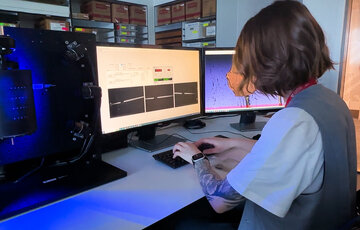What Motion Designers do and how to become one
Motion design is one of the most exciting creative careers in media and design, blending art, storytelling and technology into moving imagery that brings ideas to life. This article will guide you through the essentials on how to go from a complete beginner to confident professional.
What is Motion Design?
Motion design is the art of taking graphic design and making it move. Instead of static logos, posters or illustrations, a motion designer animates those elements, so they dance, shift and flow across a screen. This can be as simple as a title for a YouTube video, or much more complex, like designing an entire broadcast package for television.
In practice, motion design sort of sits at the crossroads of graphic design, animation and filmmaking. While animators often focus on character movement and storytelling, motion designers create animated graphics that communicate ideas, explain processes and enhance brand identity.
The process of motion graphics begins with concept development. Designers sketch ideas, create a storyboard and plan how images will move. They then bring those sketches to life using software like Adobe After Effects or Cinema 4D to layer in typography, shapes, textures and sound.
What do Motion Designers do?
A motion designer’s job is super varied and will depend on the industry and type of project that they work on.
Some of the tasks that you’ll take on include:
- Designing and animating graphics for film, television, advertising, social media and websites
- Collaborating with creative directors, illustrators, copywriters and editors
- Storyboarding ideas to communicate concepts
- Editing motion sequences so the visuals sync with audio and music
- Preparing graphics in different formats for use across platforms
These are some type of projects that you might work on (and not limited to):
- Animated logos and brand identity elements
- Broadcast graphics
- Visual effects for film and/or television
- Interactive graphics for apps and websites
- Title sequences
Collaboration is key for motion designers as they rarely work in isolation. They team up with producers, sound designers, editors and developers to create a shared result.
Here's a list of software that are commonly used by motion designers as part of their toolkit:
- Adobe After Effects is the industry standard for motion graphics
- Adobe Illustrator and Photoshop are used for creating assets and illustrations
- Cinema 3D, Blender or Maya for 3D motion work
- Premiere Pro or Final Cut Pro is used for video editing
- Figma for design collaboration and interface elements
Essential skills for Motion Designers
To really nail a career in motion design, you need both creative flair and technical know-how.
Creative skills
- Strong sense of timing, rhythm and pacing
- Ability to tell stories visually
- Solid grasp of colour, typography and layout principles
- Creative problem-solving and conceptual thinking
Technical skills
- Proficiency in After Effects and Cinema 4D
- Knowledge of 3D modelling and rendering
- Editing and compositing skills
- Comfort working with audio and syncing visuals with sound
It’s important to understand design principles and animation basics as well. Knowing how to stage a scene, anticipate motion, and use easing effectively can help separate an amateur from a professional. This is where formal study or training can help, it builds the foundation you’ll lean on when client deadlines are tight.
Career pathways for Motion Designers
Motion design is a career that offers flexibility and variety. You’ll find motion designers working in advertising agencies, design studios, film production houses, gaming companies, tech firms and even in-house creative teams.
You might start out as a junior designer, working on smaller animation tasks. With experience, the next career progression step may be the role of a senior designer or art director, where you’ll oversee teams and shape creative direction.
How much does a Motion Designer make?
The answer depends on location, experience and industry. Freelancers often charge by the project or day, while full-time roles offer steady salaries. As you build your portfolio and reputation, your salary can increase significantly. Certain industries like advertising will likely offer higher pay, and as a freelancer, your project rate can be impressive.
According to the Economic Research Institute, the average salary for a motion designer is $112,641 (NZD), with a range of $77,159 to $137,648. Globally, markets like the US, UK and Australia also report strong demand.
How to Become a Motion Designer
If you’re starting with no experience, the process may feel daunting, but think of it as building blocks.
Step one: Learn the basics of design
Start by understanding graphic design principles, including typography, colour theory, and composition. You can check out design blogs and entry-level courses to wrap your head around the basics.
Step two: Get familiar with software
Download trial versions of Adobe Creative Cloud and begin experimenting. After Effects is your new best friend, but don’t ignore Illustrator and Photoshop, as they’ll help you build assets. Free alternatives like Blender for 3D are also worth exploring.
Step three: Take a structured course
If you’re serious about turning this into a career, a formal qualification can help enormously. At Media Design School at Strayer, the Bachelor of Media Design (Motion Design) offers a clear pathway. You’ll learn not only how to use the tools but also how to think like a motion designer, work with clients and build projects from start to finish.
Step four: Build your portfolio
Your portfolio will be essential for launching your career. Start small with personal projects, like animating a favourite logo or creating short explainer videos. As you gain skills, add client or collaboration work to your folio. Keep it polished and up to date; it’s how potential employers or clients decide whether to hire you.
Step five: Connect with the community
Motion design is collaborative by nature. Join online groups, attend meetups, and follow industry leaders. Networking helps you learn from others, stay inspired and uncover opportunities. Many students land internships or jobs through connections they make during their studies.
Step six: Gain experience through projects
Internships, freelance projects and collaborative work will help you apply what you’ve learned. Every project, no matter how small, adds to your experience and confidence.
Step seven: Keep learning
Technology in motion design changes quickly. Stay on top of software updates, new plugins and industry trends. The best motion designers are curious and never stop experimenting.
By now, you should have a clearer picture of what a motion graphics designer does, and how you can become a motion designer yourself. The path isn’t about mastering everything overnight; it’s about taking steady steps, building skills, and keeping your creativity alive.
If you’re ready to start your own journey, studying motion design could be the best move you make. Check out the Bachelor of Media Design (Motion Design) to see how you can go from a complete beginner to creating moving images that capture attention worldwide.



